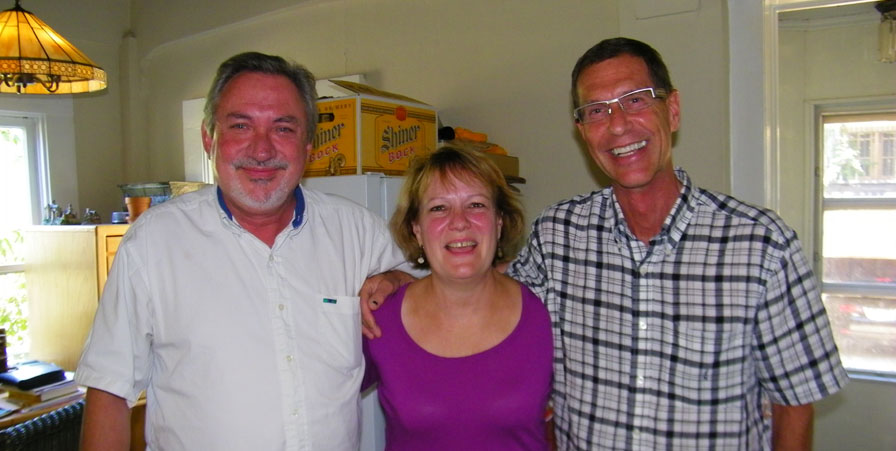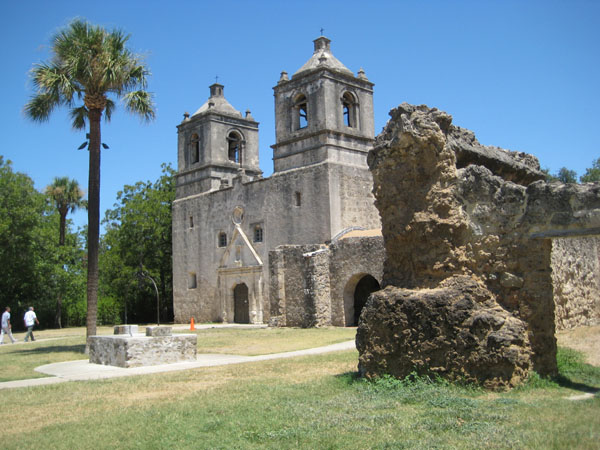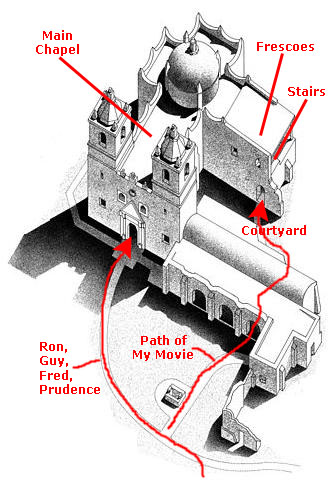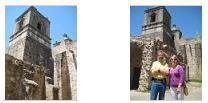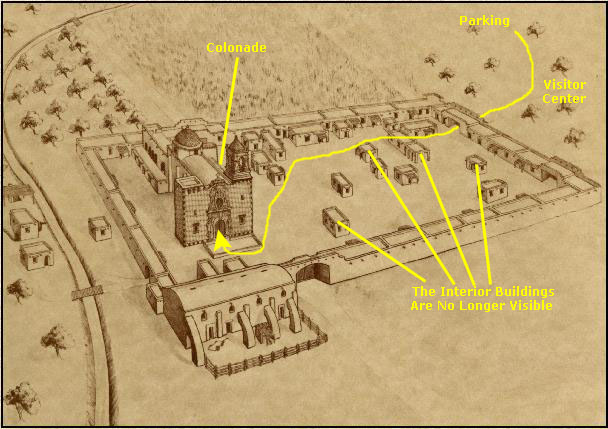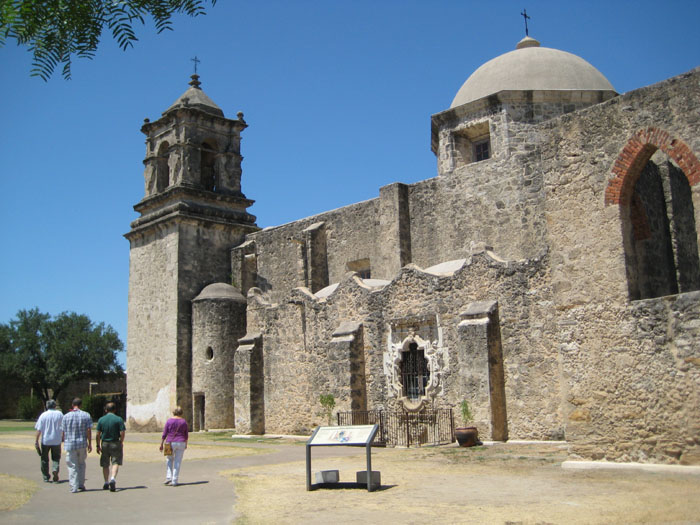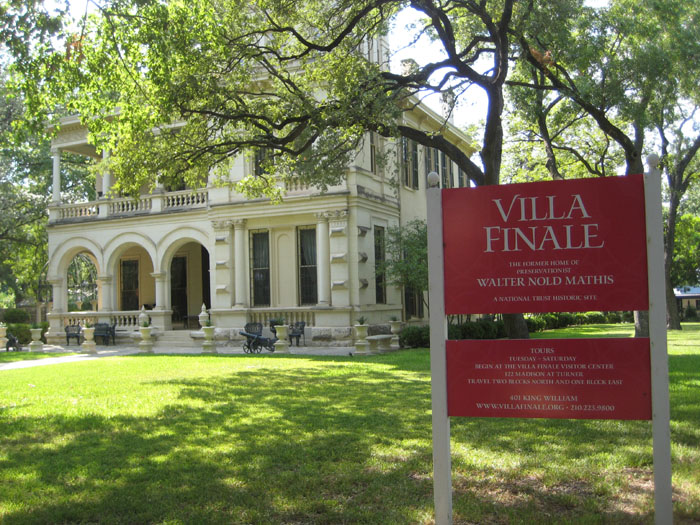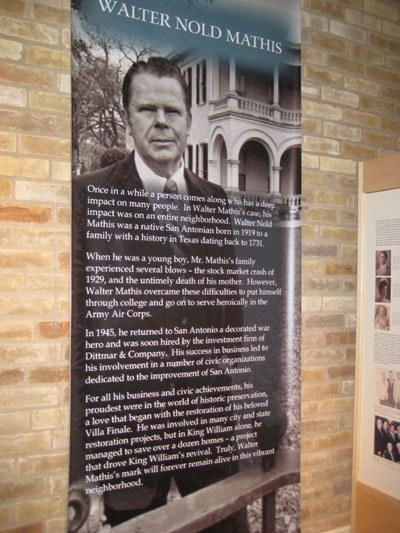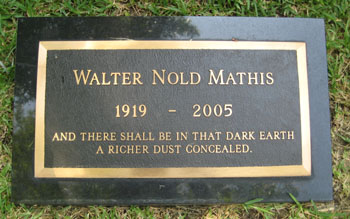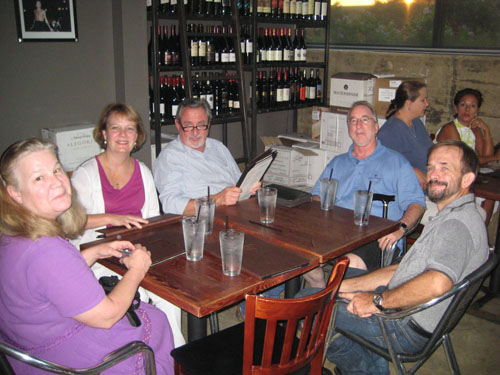
A Unique Bed & Breakfast In the Heart of San Antonio's Historic District
For some time, Ron Ruckman has planned Prudence's birthday for Friday, August 26- which is actually the date of her birthday- and of course Fred and I planned to join them.
Ron Ruckman wanted to surprise Prudence by having Guy Blair come down from Chamberlain, SD, for her birthday, but Guy could not be in San Antonio on Friday; he only had Wednesday and Wednesday night that he could spend. So that's what Guy did; he planned to fly from Chamberlain to San Antonio on Wednesday, have dinner with the Ruckmans on Wednesday and then return to South Dakota the next day. We planned a surprise for Guy. Since Guy had to fly through Dallas to get to San Antonio, and since I helped Guy with his reservations, I knew what seat he would be in on his Dallas-San Antonio flight. I arranged for Fred and I to fly down instead of driving, and I booked the two seats next to him. We planned to surprise him on the plane, and I laid the plans by telling him weeks ahead that Fred and I wouldn't be able to go down to San Antonio until Friday.
Exploring the San Antonio Missions
At left, I have put a map of the San Antonio Missions so you can see where we went. You can follow our progress along the Mission Trail by scrolling the diagram up and down. The Mission Trail actually includes five missions; from north to south they are The Alamo, Mission Concepcion, Mission San Jose, Mission San Juan and Mission Espada. All we will do today are Mission Concepcion and Mission San Jose. Fred found just before we headed out that his camera batteries were all discharged, so I will be doing the picture-taking duties this afternoon.
Ron drove us down to the parking area for Mission Concepcion and we began to walk around.
Mission Concepcion
Past the mission gate the road led north along the San Antonio River to Mission San Antonio de Valero (now known as The Alamo) and the military post of San Antonio de Bexar. to the south the road went to Mission San Jose and the two missions beyond.
The missions communicated with each other and provided mutual support even though each mission was a self-contained community. At one of the entrance signs, you can see an
artist's depiction of the mission
as it might have looked two hundred years ago. In that artist's conception, you can see that a wall surrounded the large open area in front of the actual mission buildings; this defined an area to which locals could repair in times of danger, such as Indian attacks, or gather for festivals. Just to my right as I faced the mission I could see
part of this original wall.
I went on in to the main chapel where I rejoined everyone. The first thing I did was to ask Guy and Prudence to allow me to take their picture
at the front of the chapel.
Looking up towards the ceiling at the front of the chapel, we find an old iron chandelier that once held candles but which has now been wired for electricity, and we can also see the
vaulted dome ceiling.
I was intrigued by the designs in the ceiling, and when I moved directly underneath the dome to look up, I also found that I could position my shot to be directly under the circular chandelier as well when I looked up. You can see the resulting geometric picture
here.
I took a few other pictures here in the main chapel. In one, you can see the table, chairs and
abstract depiction of the Virgin Mary
at the left side of the chapel, one of the two
hanging decorations
that evoke the aspect of the Trinity (one hangs on either side of the altar area) and, finally, looking towards the back of the chapel, the main entry and the galleries above it. You can see that last view
here.
From the main chapel, we went out through the convento back to the courtyard. It was here that we saw some of the frescoes that adorn various areas in the church. The integrity of the church and convento roofs at Mission Concepción prevented the deterioration of many
fine examples of frescoes.
This tediously applied art form covered the front of the church and most of the church and convento interiors. Today only four rooms clearly show remnants of these colorful designs painted over 250 years ago. While many of the existing frescos are simply decorative, several are symbolic. The most famous fresco, located on the convento room ceiling, is a possible depiction of God as a mestizo.
Exiting the convento, we passed
an interesting stone staircase
up to a covered balcony. Then we found ourselves in
the courtyard.
Mission builders, skilled master craftsmen recruited from Mexico, preserved the basic Spanish model, with modifications dictated by frontier conditions. The quarry from which the mission Indians dug the stone to build their community is located on the grounds of Mission Concepción. The church walls are 45 inches thick; however only the inside and outside facings are of solid stone - between the two layers is a filling of small stones and building debris. The native residents of the missions provided labor for the building of these churches. This activity was one way to foster a sense of community and provide a means of training the mission residents as artisans. As we were leaving the courtyard and heading back to the car, I asked Prudence to take one final picture of
Fred and me at Mission Concepción.
Mission San Jose
So rich an enterprise was a natural target for Apache and Comanche depredations. Although they could not prevent raids on their livestock, the mission itself was almost impregnable. In his journal, Fray Juan Agustín Morfí attested to its defensive character: "It is, in truth, the first mission in America . . . in point of beauty, plan, and strength . . . there is not a presidio along the entire frontier line that can compare with it." The danger was when working the fields or during travel to and from the ranch or other missions. With technical help from the two presidial soldiers garrisoned there, San José residents learned to defend themselves. Already proficient with bow and arrow, the men also learned the use of guns and cannon.
We entered the mission from the south, although that was not the main entrance centuries ago; the church itself faces west. I have marked the current location of the parking area and visitor center on the diagram. We followed one of the walkways north and around to the main entrance to the church proper.
Much of what is visible today at Mission San José was reconstructed by the Works Progress Administration in the 1930s, and today about 80% of the church is original. The National Park Service, with help from taxpayers and the park's friends group, Los Compadres, is responsible for the the extant structures and historical landscape. The granary and the convento required stabilization and some reconstruction work. Other areas, notably the church and the colonnade, were beautifully restored in the late twentieth century, and about ten years ago a new visitor center was constructed. Today, Mission San Jose is is very good shape, and is a wonderful destination.
Inside the church, we walked forward to
the beautifully-restored sacristy
to admire the blue-and-gilt carvings. Fred took a picture of
me at the sacristy,
and I turned around to get a picture of the rear portion of
the chapel.
In this movie, I am standing in the middle front of the main aisle in the church, and, beginning with the ornate blue carved altar wall, I pan around the chapel.
As we exited the chapel through a side convento, I stopped to snap a picture of Prudence next to a colorful arrangement of serapes, flowers and a depiction of the Virgin Mary, and you can see that picture
here.
Then we went through a beautiful
arched doorway
out to the south rear area of the church and the amazing series of arched colonnades.
Prudence and I have left the convento building, and are now out in the garden area that has the double-height arches running along one side. This movie will show you the area.
This was our last stop this afternoon. After seeing two of the San Antonio Missions, we returned to Ruckman Haus to get ready for Prudence's birthday celebration on the San Antonio Riverwalk.
Prudence's Birthday Cruise
In this movie, you'll see what our cruise boat looks like and I'll introduce you to everyone who will be helping Prudence celebrate her birthday.
Before we headed out, I made a movie of our group. You'll get a better view of our boat here in this movie.
I took a couple of pictures of our group, too, and you can see them if you click on the thumbnails below:
We have returned to the restaurant to be served our meals, and now we've headed out again. As
eat our dinner,
we are slowly cruising the San Antonio River while our pilot regales us with stories and information.
RiverCenter, a brightly-lit, multi-storey shopping mall is at the end of the only cul-de-sac on the Riverwalk System. I took advantage of the light to film our cruise down the side canal and our turnaround in front of RiverCenter.
Ron has had Fred and I on these river cruises two times before, and we have enjoyed it each time. Fred and I thank Ron and Prudence profusely for allowing us to help them celebrate this evening and for the next two days.
Guy's Departure
A Tour of Villa Finale
Villa Finale is overflowing with Mathis’ 12,500 piece collection which includes distinctive examples of European furniture, ceramics, silver, and fine art. Mathis particularly enjoyed collecting memorabilia surrounding the life and death of Napoleon Bonaparte. The collection also includes a number of prominent Texas artists such as Mary Bonner, and Julian and Robert Onderdonk. Additionally, there is a wide range of Texas decorative arts, such as Bell silver, Texas furniture, and Texian campaign ceramics.
As with many tours of old homes, pictures were not allowed inside the mansion, so Fred could not get images of some of the collection inside. He did take a number of good pictures of the house and grounds, and I've selected the best of them to include here. Since I wasn't on the tour with them, I haven't been able to supply descriptions, but I think most of them should be self-explanatory. Just click on any of the many thumbnail images below to view his pictures:
Dinner at Zinc
Before we started our meal at Zinc, I made a movie of all of the attendees (including myself), and you can watch that movie with the player at left. I also got a nice picture of
Prudence and Nancy.
Karl took some good pictures of Prudence, her sister and the rest of us during our time here in San Antonio, and I want to include some of them here. To view the pictures, just click on the thumbnails below:
|
||||||||||||||||||||||||||||||||||||||||||||||||||||||||||||||||||||||||||||||||||||||||
|
Ron and Prudence Ruckman
stay@ruckmanhaus.com |




